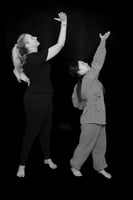When it comes to the world of mind-body practices and martial arts, the relationships between...
Practice Active Balance in Tai Chi
Discover the importance of active balance in Tai Chi practice and how it can enhance your physical and mental well-being.

The Concept of Active Balance in Tai Chi
Active balance in Tai Chi refers to the ability to move with ease and confidence while maintaining a stable and centered posture. It goes beyond simply standing on one leg for a long time, as it encompasses the functional aspects of balance in daily movements such as walking, turning, and moving. The iconic yoga tree pose may test balance, but Tai Chi focuses on practical balance that can be applied to everyday activities.
Qi Gong, a practice closely related to Tai Chi, exemplifies the concept of active balance. Even at the age of 95, my oldest Qi Gong student effortlessly embodies the bird pose, reminding us that balance is not limited to static poses but extends to how we navigate through life.

Benefits of Embracing Active Balance in Tai Chi
Embracing active balance in Tai Chi offers numerous benefits for both the body and mind. By training our bodies and brains to work together harmoniously, we enhance our coordination, flexibility, and strength. The repetitive movements and focused attention required in Tai Chi promote mindfulness and improve mental clarity and concentration.
Active balance in Tai Chi also helps to improve posture and alignment, reducing the risk of falls and injuries. It enhances proprioception, the body's awareness of its position in space, which can be especially beneficial for older adults. Additionally, active balance cultivates a sense of groundedness and stability, promoting a calm and centered state of being.

Practical Tips for Achieving Active Balance in Tai Chi
To achieve active balance in Tai Chi, it is important to focus on the following practical tips:
- Start with a stable foundation: Begin by establishing a strong and grounded stance, with the feet shoulder-width apart and the knees slightly bent. Distribute your weight evenly between both legs.
- Engage the core: Activate your abdominal muscles to support your posture and maintain stability throughout the movements.
- Relax the upper body: Keep your shoulders relaxed and allow your arms to flow naturally, maintaining a sense of lightness and ease.
- Maintain a steady breath: Breathe deeply and evenly, coordinating your breath with the movements to promote a calm and centered state of mind.
- Practice mindfulness: Stay present and fully engaged in the practice, paying attention to the sensations in your body and the alignment of your movements.
By incorporating these practical tips into your Tai Chi practice, you can enhance your active balance and experience the full benefits of the art.

Incorporating Active Balance into Daily Tai Chi Practice
While Tai Chi can be practiced formally in dedicated sessions, it is also important to incorporate active balance into your daily life. Here are some ways to do so:
- Mindful walking: Pay attention to your balance and posture while walking, focusing on maintaining a centered and stable stance. Envision each step as a Tai Chi movement, flowing smoothly and effortlessly.
- Turning with grace: When changing directions, whether in daily activities or during Tai Chi practice, practice turning with grace and fluidity. Use your core muscles to initiate the movement and maintain balance throughout.
- Everyday movements as practice: Approach everyday movements such as reaching for an object or bending down with the same mindfulness and attention to active balance as you would in Tai Chi. This allows you to apply the principles of active balance to functional movements.
By incorporating active balance into your daily Tai Chi practice, you can further integrate the benefits of Tai Chi into your everyday life, promoting overall well-being.
Mindful Awareness and Active Balance in Tai Chi
Mindful awareness is a key component of active balance in Tai Chi. By cultivating a state of present-moment awareness, you enhance your ability to maintain balance and move with ease.
During your Tai Chi practice, bring your attention to the sensations in your body, the alignment of your movements, and the flow of your breath. Notice any areas of tension or imbalance and consciously relax and realign yourself. By maintaining mindful awareness, you can fine-tune your active balance and deepen your connection between body and mind.
Incorporate mindfulness into your Tai Chi practice by setting aside distractions and creating a dedicated space and time for your practice. By immersing yourself fully in the present moment, you can fully embrace active balance and experience the transformative power of Tai Chi.




